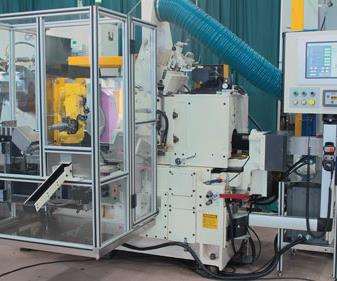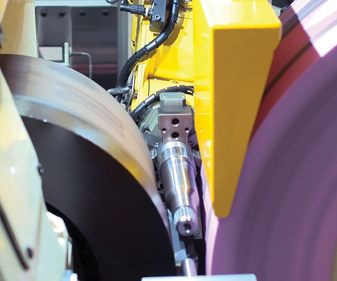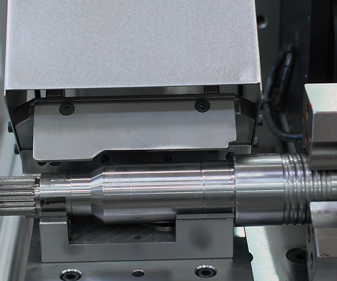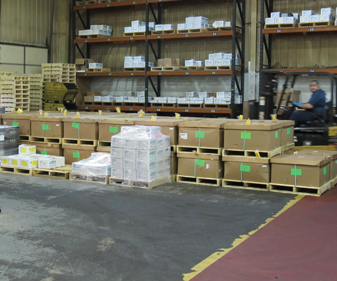Automated Grinding Cell Adds Capacity
Like many shops facing changes in customer demands, Pennsylvania-based American Turned Products (ATP) is making the necessary adjustments and adding operations to continue to compete in the difficult, high volume market. One of those adjustments is the company’s recent installation of an automated centerless grinding cell.
Editor's note: See a video of the grinding cell in operation below.
Like many shops facing changes in customer demands, Pennsylvania-based American Turned Products (ATP) is making the necessary adjustments and adding operations to continue to compete in the difficult, high volume market. One of those adjustments is the company’s recent installation of an automated centerless grinding cell.
The centerless grinding cell at ATP is a harbinger of trends that seem to be happening across the spectrum of precision machined parts manufacturing. Many shops are augmenting traditional, high volume production techniques with what might have once been considered non-traditional operations and incorporating automation in these operations.
Once, the screw machine industry was a well-defined demographic. Its primary differentiator from other metalworking shop segments was the use of cams to actuate the axes of machine tools to produce relatively small parts in large volumes. Today, the cam world is still with us, but an aging workforce is making experienced cam setup increasingly difficult to find.
Companies are moving on to CNC and servo technology for its programmability to help attract younger people, and for its production flexibility to do more, different jobs. In many cases, the cam department has morphed into the programming department, which has opened up new operational opportunities—G code is G code, regardless of the machining process.
That’s one of the drivers that lead ATP to invest in an automated centerless grinding cell for production of a motor drive shaft job. According to Harry Eighmy, chief operating officer and second-generation owner of ATP, this job took the company out of its comfort zone, but has opened up new opportunities.
New Job, New Approach
Compared with the parts that ATP typically processes, the motor drive shaft job is significantly larger and heavier. Typical ATP parts weigh ounces, while the blanks for the new job start out more than 2 pounds.
“We weren’t set up to deal with the weight this job was going to bring into the shop,” Mr. Eighmy says. “We started out manually grinding these parts and quickly realized the process needed to be automated, first, to hit production (it’s a high volume job of 20,000 to 25,000 parts per week) and second, to remove the operator fatigue factor and its resultant quality issues.”
At 2 pounds per blank, two blanks per cycle, and a 15- to 20-second cycle time, the operator is loading 480 pounds per hour. Mr. Eighmy realized that was not sustainable. Moreover, tolerances on the ground surfaces—2 microns—required much higher precision than could be achieved with a manual process. It needed to be error-free.
This realization put ATP in touch with Chicago-based Allways Precision Inc. systems integrator and specialist in rebuilding Cincinnati centerless grinders. The challenge was to get an automated centerless grinding cell up and running in about 10 weeks. In addition, ATP needed to invest in automating the blank turning operation upstream from the grinder.
Getting Ready to Grind
To get started, ATP looked at the beginning of the process, which was handling the raw material—1144 steel at 35 RC hardness. To balance the cycle times between the lathes and the grinder, three lathes are used to feed motor drive shaft blanks to the grinder.
Op. 10 and 20 are performed on each lathe using its subspindle. The blanks from each lathe use witness marks that allow traceability to the machine it was made on, should any quality issues arise.
In addition to bar feeders and to simplify raw material handling, the company invested in bundle loaders for the lathes. Their ability to accept a bundle of barstock at a time allows sufficient storage and processing capacity to supply raw material to feed the grinding cell.
Once the parts are blanked and cut off, they are output to an accumulator next to the lathe. From the accumulator, the blanks are cell packed at the lathe for transport to the grinding machine. From the box, they are loaded into an input conveyor that feeds the robot.
The Daily Grind
The foundation of the grinding cell is a model 200 Cincinnati centerless grinder. Allways Precision rebuilt the machine to include the most current technology for programmability, including automatic closed-loop wheel wear compensation, automatic dressing and profiling. It also includes automatic in-process parts gaging. The cell is tended by a FANUC LR Mate robot.
“The grinder cell is really slick,” Mr. Eighmy says. “With the manual loading process, we had about 15-percent scrap. With the robot loader, that came down to less than 1 percent. In addition to lowering the scrap rate, the output from the grinder improved by 35 percent with the robot.”
The cell has automatic gaging as part of the process that checks tolerances on the shaft journals, which are the ground features of the part. After the grind, the parts go through a rust preventative process, and then are repacked before heading to shipping. They leave ATP “line-ready” for the customer. The cell runs 24 hours and is in production four to five days a week to make the weekly production volume.
When running manual, it took two and a half people to manage the process. Now the process is managed by one person.
“If you do the personnel math,” Mr. Eighmy says, “that’s two and a half times three shifts, which were needed because the output was lower. Now, we run 20 hours a day in two, 10-hour shifts with two people, when before we ran production with seven and a half people. For our shop, that’s a significant improvement. Eliminating the manual handling of these heavier parts has also improved morale for the operators who were doing that job. The material handling improvements has resulted in a much safer and ergonomically efficient manufacturing process to manufacture these motor drive shafts.”
Engineering the Cell
To find out how an installation such as the grinding cell comes into being, we contacted Rick Lang, V.P. and engineer at Allways Precision. He worked on the ATP project and shared some insights and clever solutions that have helped make this system successful for ATP.
Allways Precision became involved in the ATP project when Willie Eichele at the Cleveland distributor, Motch and Eichele, sent in some sample parts that customer ATP was bidding on. Mr. Lang looked at the job and determined the best grinding sequence along with how much stock to leave on two of the three critical journals.
“When we first looked at the job,” Mr. Lang says, “the plan was only to grind two journals using an infeed process on the centerless grinder. Once we returned the samples to ATP, they gave us additional targets such as cycle times, floor space requirements and a fairly tight delivery and installation schedule.”
To meet the delivery schedule, Romas Juodvalkis, the owner of Allways Precision, took a leap of faith and had the engineering team start the build prior to ATP acquiring the order. “Sometimes it’s how we have to operate,” Mr. Lang says.
Building a machine from scratch would not have met the delivery schedule, but since Allways Precision keeps a large inventory of machines, most of that was not an issue. The machine chosen for the job is a Cincinnati 220-8 centerless grinder, which uses a 24-inch diameter grinding wheel that is 8 inches wide. For this cell, Allways added a FANUC robot, custom gaging and input/output conveyor systems.
As ATP was getting the blank turning machines set up to run the raw materials, Allways moved forward in parallel with the cell development. The grind stock recommendation for each of the blank’s journals is 0.007 to 0.008 inch.
Along the way, it was determined that the infeed could be engineered to grind all three journals in a single cycle by pushing the part across and past the wheel in order to grind all three journals. The part then retracts so the robot can unload it. This single-pass cycle meant the parts would come off the grinder complete.
“Our original thought for the robot was to use a dual gripper for part load and unload,” Mr. Lang says. “Along the way, we switched our thinking to a single gripper and installed a dead nest to queue the parts for the robot. Basically, the dead nest is a fixture that holds two parts, one part to be loaded into the machine and one that is complete and ready to be gaged. It’s simple, but effective and eliminates the need for a second gripper. Because the finished part can be gaged and discharged while the machine is in cycle, there is no parasitic time to impact the 15-20 second cycle time we were shooting for.” The gage station is built by Allways and is capable of measuring plus/minus 0.25 micron.
To accommodate the ATP’s initial floor space concern, the robot, dead nest and gaging station all fit within a 3- by 3-foot enclosure that is attached to the grinder. To access the grinder, the enclosure is hinged, so the operator can pull a single pin and move the enclosure to change wheels or perform other tasks within the workzone. “You can be inside changing a wheel in about 3 to 5 minutes,” Mr. Lang says.
The wheel dresser is programmable and was made for retrofit on Cincinnati machines by Allways. It has a resolution of 0.000005 inch on the radius. The dresser uses million count motors at 5-to-1 ratios, which gives the 0.000005-inch resolution. The servos are backed up by linear encoders, which when compared with the servo feedback, give true positioning.
“One of the tricks in programming the dressing cycle to this job,” Mr. Lang says, “was to make sure the wheel breakdown was consistent because it is grinding three different diameters, which means three different grinding rates.”
The journals coming from the cell are produced to an Ra of 8 -10. Roundness, the critical specification, is consistently held to 1 micron. The key to success for ATP is that the production from this automated cell is consistent. Being able to ship high volume, high tolerance parts line-ready, on a daily basis is an important benefit for ATP.
A Believer
Mr. Eighmy admits that installing this grinding cell and working with a quality integrator has been an eye-opening experience. “It has changed how we approach the art and science of manufacturing,” he says. “I underestimated the amazing flexibility that integration of modern robotics can bring to an application. In fact, we are currently adding automation to a rotary transfer cell in our sister plant.”
With the side by side comparison that ATP was able to make between using a manual centerless operation and the automated cell, the efficiency of automation is clear. Being able to count on fit, function, characteristic checking and mistake proofing, which has led from scrap rates of 15 percent to less than 1 percent is raising the bar at ATP and in many shops around the country.
Looking to the future, a difference between this technically updated manufacturing cell and the typical hard automation that came before is the ability to repurpose it. Should ATP lose the job that is currently running, without too much tweaking, the cell can be configured to make a different part. Programmability is the key to flexibility.
RELATED CONTENT
-
Checklist for Lights-Out Manufacturing
Many shops of various sizes are trying to hop on the lights-out bandwagon. This article looks at some things to consider and check out before “hopping.”
-
10 Smart Steps to Take Toward Recovery
With many manufacturers facing challenges in light of the novel coronavirus pandemic, these 10 steps can help position manufacturers to find success.
-
Automating CNC Lathe Part Loading/Unloading
Read about how you can automate the loading/unloading of your CNC lathes to reduce the labor cost on longer running jobs.







